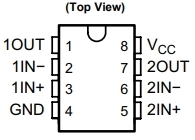
Integrator, Differentiator, Summer, adder, Voltage follower, etc.Power drain suitable for the operation of the battery.Two operational amplifiers of this IC are compensated internally.Similarly, we can get output from Op-Amp 2.

If the input voltage 1 is less than the input voltage 2, then the output of the op-amp stays at VCC, which means the output voltage is HIGH (VCC). If the input voltage 1 is greater than the input voltage 2, then the output of the op-amp will be drawn down to the ground, which means the output voltage is Low (GND). First of all, we provide input voltage 1 to the Inverting terminal (Pin2) and input voltage 2 to the Non-Inverting Terminal (Pin3). This low-cost device features an Arduino Nano to read the iron temperature via an LM358 op-amp, and regulates power to the handle and tip under PWM control using an IRFZ44N MOSFET.

As an example, here we used the Op-Amp1 of the LM358 IC to get output. If you want to upgrade your soldering setup without spending a lot of money, then be sure to check out Angelo Casimiro’s DIY Hakko 907 station.


 0 kommentar(er)
0 kommentar(er)
